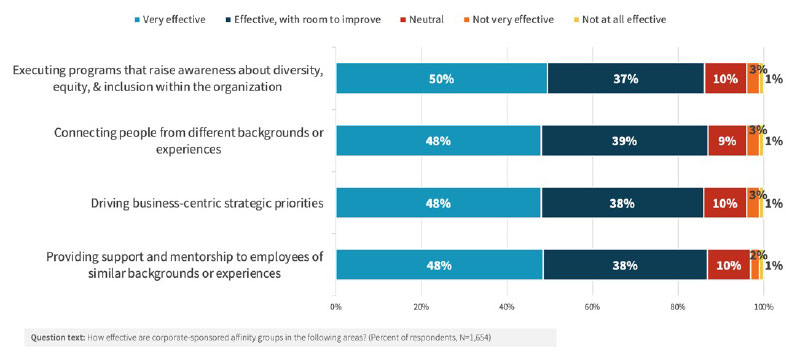Corporate-supported workplace affinity groups, also called employee resource groups, have become an important part of Diversity, Equity, and Inclusion (DE&I) initiatives at many organizations. These groups serve a variety of purposes, including raising DE&I awareness across organizations and driving business-centric strategic priorities. Research that AWS commissioned TechTarget’s Enterprise Strategy Group to conduct shows that 83% of organizations said they have affinity groups in place.1
As part of the research, respondents cited four potential areas where affinity groups could have a positive impact on their organization. At least 86% of respondents said affinity groups in their organization were effective in each of the areas shown in Figure 1.
Figure 1: How effective are corporate-sponsored affinity groups in the following areas?
Other benefits of affinity groups include fostering collaboration and synergy; making new employees feel welcomed; building community; opening lines of communication; improving morale and job satisfaction; helping employers address discrimination concerns; promoting friendships; creating a corporate culture that attracts both younger workers and a more diverse workforce; and realigning company policies to meet the changing needs of employees.
Affinity groups can take a number of different forms within organizations to enhance and promote DE&I. They can be started organically by employees, or they can be sponsored by corporate management, human resources, lines of business or others. They can be specific to individuals of similar backgrounds—race, ethnicity, gender identity, lifestyle, or sexual orientation, for example—or they can be used as a bridge to connect people from different backgrounds or experiences.
Affinity groups are typically voluntary and employee led, and are more valuable and visible when they have the support and encouragement of corporate leadership. As described by the Human Resource Certification Institute (HRCI), affinity groups offer benefits such as a more inclusive corporate culture and improved recruitment and retention. But HRCI adds a caveat: Business and HR leaders need to ensure that affinity groups are aligned with organizational objectives to optimize their use of time and resources.2
HRCI suggests several best practices to cultivate mutually beneficial results for both the organization as a whole and for individual affinity group members. These are:
- Develop leaders for succession planning. This includes putting resources toward developing affinity group leaders and members, such as funding scholarships for professional certifications or providing the time and money to attend professional development conferences. HRCI suggests giving affinity groups the opportunity to lead in the organization as a whole by providing resources for them to host events or presentations.
- Align expectations from affinity groups. Set boundaries and expectations. Don’t expect affinity groups to write DE&I policies or fix problems within the organization, but rely on them as an important component of diversity and inclusion strategies. Give affinity groups credit when they are involved in creating or implementing innovative business ideas. Compensate members by allowing them to meet on company time, and give them a budget to work with.
- Give diverse voices a platform. Affinity groups and their leaders can offer valuable insights into how organizations can improve policies and work experiences. As noted by HRCI, “Affinity groups give individuals a platform so that their voices are heard within the organization, especially when decisions are being made. You can ask leaders to bring that voice to DE&I and other committees as representatives of their affinity groups.”
A Mature Approach to Diversity, Equity, and Inclusion Delivers Real Results
Read this paper to learn how enterprises foster mature DE&I programs and the business impacts their efforts drive.
Download NowTaking the next step
The research from ESG and AWS provides measurable evidence of the value of corporate-supported affinity groups in supporting DE&I efforts and driving business-centric strategic priorities. As organizations of all types across all industries look to DE&I as a way to serve the greater good, improve ROI and foster a more inclusive corporate culture, affinity groups can and should be an important part of the equation.
For more information on how your organization can maximize the business benefits of its DE&I strategies, including affinity groups, please review the additional articles and resources on this site.
1“A Mature Approach to Diversity, Equity, and Inclusion Delivers Real Results,” TechTarget’s Enterprise Strategy Group Research Insights report commissioned by AWS, March 2023
2“Making the Most of Employee Affinity Groups,” HRCI Learning Center, Feb. 14, 2022

